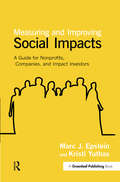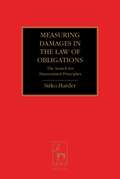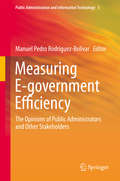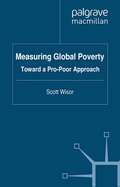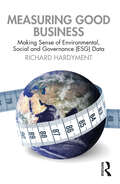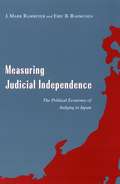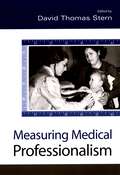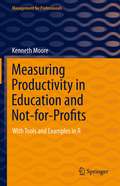- Table View
- List View
Means, Ends, and Persons: The Meaning and Psychological Dimensions of Kant's Humanity Formula
by Robert AudiNo one wants to be treated merely as a means-"used," in a sense. But just what is this repugnant treatment? Audi's point of departure is Kant's famous principle that we must treat persons as ends in themselves and never merely as means. Treatment of these kinds is conduct, a complex three-dimensional notion whose central elements are action, its motivation, and the manner of its performance. He shows how the notions of treating persons as ends and, by contrast, merely as means, can be anchored outside Kant and clarified in ways that enhance their usefulness both in ethical theory and in practical ethics, where they have much intuitive force. Audi constructs an account of treatment of persons-of what it is, how it differs from mere interpersonal action, and what ethical standards govern it. In accounting for such treatment, the book develops a wider conception of ethics than is commonly implicit in utilitarian, deontological, or virtue theories. These results contribute to ethical theory, but in its discussion of diverse narrative examples of moral and immoral conduct, the book also contributes to normative ethics. Audi's theory of conduct takes account of motivational elements that are not traits of character and of behavioral elements that are not manifestations of virtue or vice. Here it goes beyond the leading virtue approaches. The theory also advances rule ethics by framing wider conception of moral behavior-roughly, of acting morally. The results advance both normative ethics and ethical theory. For moral philosophy, the book frames conceptions, articulates distinctions, and formulates principles; and for practical ethics, it provides a multitude of cases that illustrate both the scope of moral responsibility and the normative standards for living up to it.
Means of Transportation and Registration of Nationality: Transportation Registered by International Organizations (Routledge Research in International Law)
by Vincent P. Cogliati-BantzThis book examines the concept of nationality of means of transportation in terms of jurisdiction in international law. It reassesses the definition of nationality and explores how it is conferred. The book first places nationality in the broader perspective of jurisdiction in international law, and examines the historical development and necessity of the nationality of means of transportation. It goes on to investigate whether and under which conditions international organizations may confer a ‘nationality’ on means of transportation, examining the law of the sea conventions and air and space treaties. The book finally explores several questions relating to international registration of means of transportation, building a regime of international registration. Vincent Cogliati-Bantz introduces a necessary distinction between transport internationally registered and transport registered in a State but fulfilling a mission for an international organization. As a work that proposes the ability for international organisations to access international spaces without reliance on State-registered means of transport, this book will be of great use and interest to scholars and students of public international law, international organisations, and maritime, space, and aviation law.
Means of Transportation and Registration of Nationality: Transportation Registered by International Organizations (Routledge Research in International Law)
by Vincent P. Cogliati-BantzThis book examines the concept of nationality of means of transportation in terms of jurisdiction in international law. It reassesses the definition of nationality and explores how it is conferred. The book first places nationality in the broader perspective of jurisdiction in international law, and examines the historical development and necessity of the nationality of means of transportation. It goes on to investigate whether and under which conditions international organizations may confer a ‘nationality’ on means of transportation, examining the law of the sea conventions and air and space treaties. The book finally explores several questions relating to international registration of means of transportation, building a regime of international registration. Vincent Cogliati-Bantz introduces a necessary distinction between transport internationally registered and transport registered in a State but fulfilling a mission for an international organization. As a work that proposes the ability for international organisations to access international spaces without reliance on State-registered means of transport, this book will be of great use and interest to scholars and students of public international law, international organisations, and maritime, space, and aviation law.
Measurement Uncertainty in Forensic Science: A Practical Guide
by Suzanne BellIn the courtroom, critical and life-changing decisions are made based on quantitative forensic science data. There is often a range in which a measured value is expected to fall and, in this, an inherent uncertainty associated with such measurement. Uncertainty in this context is not error. In fact, estimations of uncertainty can add to the utility and reliability of quantitative results, be it the length of a firearm barrel, the weight of a drug sample, or the concentration of ethanol in blood. Measurement Uncertainty in Forensic Science: A Practical Guide describes and defines the concepts related to such uncertainty in the forensic context. The book provides the necessary conceptual background and framework—a baseline—for developing and deploying reasonable and defensible uncertainty estimations across forensic disciplines. Information is presented conceptually, using easily understood examples, to provide a readable, handy reference for scientists in the laboratory, as well as investigators and legal professionals who require a basic understanding of the science underpinning measurement results.
Measurement Uncertainty in Forensic Science: A Practical Guide
by Suzanne BellIn the courtroom, critical and life-changing decisions are made based on quantitative forensic science data. There is often a range in which a measured value is expected to fall and, in this, an inherent uncertainty associated with such measurement. Uncertainty in this context is not error. In fact, estimations of uncertainty can add to the utility and reliability of quantitative results, be it the length of a firearm barrel, the weight of a drug sample, or the concentration of ethanol in blood. Measurement Uncertainty in Forensic Science: A Practical Guide describes and defines the concepts related to such uncertainty in the forensic context. The book provides the necessary conceptual background and framework—a baseline—for developing and deploying reasonable and defensible uncertainty estimations across forensic disciplines. Information is presented conceptually, using easily understood examples, to provide a readable, handy reference for scientists in the laboratory, as well as investigators and legal professionals who require a basic understanding of the science underpinning measurement results.
Measuring and Improving Social Impacts: A Guide for Nonprofits, Companies and Impact Investors
by Marc J. Epstein Kristi YuthasIdentifying, measuring and improving social impact is a significant challenge for corporate and private foundations, charities, NGOs and corporations. How best to balance possible social and environmental benefits (and costs) against one another? How does one bring clarity to multiple possibilities and opportunities? Based on years of work and new field studies from around the globe, the authors have written a book for managers that is grounded in the best academic and managerial research.It is a practical guide that describes the steps needed for identifying, measuring and improving social impact. This approach is useful in maximizing the impact of different types of investments, including grants and donations, impact investments, and commercial investments.With numerous examples of actual organizational approaches, research into more than fifty organizations, and extensive practical guidance and best practices, Measuring and Improving Social Impacts fills a critical gap.
Measuring and Improving Social Impacts: A Guide for Nonprofits, Companies and Impact Investors
by Marc J. Epstein Kristi YuthasIdentifying, measuring and improving social impact is a significant challenge for corporate and private foundations, charities, NGOs and corporations. How best to balance possible social and environmental benefits (and costs) against one another? How does one bring clarity to multiple possibilities and opportunities? Based on years of work and new field studies from around the globe, the authors have written a book for managers that is grounded in the best academic and managerial research.It is a practical guide that describes the steps needed for identifying, measuring and improving social impact. This approach is useful in maximizing the impact of different types of investments, including grants and donations, impact investments, and commercial investments.With numerous examples of actual organizational approaches, research into more than fifty organizations, and extensive practical guidance and best practices, Measuring and Improving Social Impacts fills a critical gap.
Measuring and Monitoring Children’s Well-Being (Social Indicators Research Series #7)
by Asher Ben-Arieh Natalie Hevener Kaufman Arlene Bowers Andrews Robert M. George Bong Joo Lee L. J. AberToday, any regular newspaper reader is likely to be exposed to reports on manifold forms of (physical, emotional, sexual) child abuse on the one hand, and abnormal behavior, misconduct or offences of children and minors on the other hand. Occasionally reports on children as victims and children as offenders may appear on the same issue or even the same page. Rather seldom the more complex and largely hidden phenomena of structural hostility or indifference of society with a view to children are being dealt with in the press. Such fragmentary, ambiguous, incoherent or even contradictory perception of children in modem society indicates that, firstly, there is a lack of reliable information on modem childhood, and secondly, children are still treated as a comparatively irrelevant population group in society. This conclusion may be surprising in particular when drawn at the end of The Century of the Child proclaimed by Ellen Key as early as 1902. Actually, there exist unclarities and ambiguities about the evolution of childhood in the last century not only in public opinion, but also in scientific literature. While De Mause with his psycho-historic model of the evolution of childhood, comprising different stages from infanticide, abandonment, ambivalence, intrusion, socialisation to support, underlines the continuous improvement of the condition of childhood throughout history and thus rather confirms Key's expectations, Aries, with his social history of childhood, seems to hold a more culturally pessimistic view.
Measuring Crime: Behind the Statistics (ASA-CRC Series on Statistical Reasoning in Science and Society)
by Sharon L. LohrCrime statistics are everywhere, but how do you know when they’re valid? If a newspaper report says "the rate of overall violent crime decreased by 0.9 percent," how can you tell where that statistic came from, what it measures, and how accurate it is? Is it worth repeating or sharing? Measuring Crime: Behind the Statistics gives you the tools to interpret and evaluate crime statistics’ quality and usefulness. The book focuses on ways of thinking about crime statistics (no formulas!) and features Eight questions you should ask before quoting a statistic The two sources of information about homicide FBI statistics: what do they measure? How victimization surveys can reflect your experiences even though you were not asked to participate Special considerations when interpreting statistics about sexual assault and fraud Examples of experiments and studies on how to improve crime statistics Two online supplements containing additional details and links to data sources Whether you are a law enforcement professional, journalist, student, or interested citizen, Measuring Crime: Behind the Statistics will tell you how to read statistics as a statistician would. Sharon Lohr, the author of Sampling: Design and Analysis, has published widely about statistical methods for education, public policy, law, and crime. She has been recognized as Fellow of the American Statistical Association, elected member of the International Statistical Institute, and recipient of the Gertrude M. Cox Statistics Award and the Deming Lecturer Award. Formerly Dean’s Distinguished Professor of Statistics at Arizona State University and a Vice President at Westat, she is now a freelance statistical consultant and writer. Visit her website at www.sharonlohr.com. "The book aims to achieve two goals: introduce statistical ideas to a general audience and provide an overview of US crime statistics. These are disparate topics, but in the way they are approached here, there is a strong synergy that reinforces both aspects. One the one hand, the reader's natural curiosity about crime (what is it, how are crime events classified and reported, how reliable are the numbers you see in the newspaper, etc.) will help him/her become interested in the statistical issues and learn these concepts in a practical and concrete setting. And on the other hand, by reading about the statistical issues surrounding crime data, he/she gains a better appreciation for the complexities of crime statistics, eventually acquiring a deeper understanding of them. As a statistician myself, I learned interesting facts about the types of crime, their nomenclature and the possible confusion surrounding them, and how the data are collected and reported. Overall, I think the combination is effective and very well developed in this book." (Jean Opsomer, Westat) "This book is an excellent primer on handling the mass of data and information researchers are faced with. While it is geared toward followers of criminal justice information, much of the book is a very good introduction to survey techniques discussing their strong and weak points. Most importantly, there are very good guidelines and questions that one should employ before citing any data or using data for policy decisions or for reporting on data such as journalists do. The book is written in a non-technical manner and does a very good job of explaining the nuances in reviewing data. Any researcher who utilizes data would find this valuable. While it has specific examples in the criminal justice field, it really is quite useful for any user of data." (Barry Nussbaum, former President American Statistical Association)
Measuring Crime: Behind the Statistics (ASA-CRC Series on Statistical Reasoning in Science and Society)
by Sharon L. LohrCrime statistics are everywhere, but how do you know when they’re valid? If a newspaper report says "the rate of overall violent crime decreased by 0.9 percent," how can you tell where that statistic came from, what it measures, and how accurate it is? Is it worth repeating or sharing? Measuring Crime: Behind the Statistics gives you the tools to interpret and evaluate crime statistics’ quality and usefulness. The book focuses on ways of thinking about crime statistics (no formulas!) and features Eight questions you should ask before quoting a statistic The two sources of information about homicide FBI statistics: what do they measure? How victimization surveys can reflect your experiences even though you were not asked to participate Special considerations when interpreting statistics about sexual assault and fraud Examples of experiments and studies on how to improve crime statistics Two online supplements containing additional details and links to data sources Whether you are a law enforcement professional, journalist, student, or interested citizen, Measuring Crime: Behind the Statistics will tell you how to read statistics as a statistician would. Sharon Lohr, the author of Sampling: Design and Analysis, has published widely about statistical methods for education, public policy, law, and crime. She has been recognized as Fellow of the American Statistical Association, elected member of the International Statistical Institute, and recipient of the Gertrude M. Cox Statistics Award and the Deming Lecturer Award. Formerly Dean’s Distinguished Professor of Statistics at Arizona State University and a Vice President at Westat, she is now a freelance statistical consultant and writer. Visit her website at www.sharonlohr.com. "The book aims to achieve two goals: introduce statistical ideas to a general audience and provide an overview of US crime statistics. These are disparate topics, but in the way they are approached here, there is a strong synergy that reinforces both aspects. One the one hand, the reader's natural curiosity about crime (what is it, how are crime events classified and reported, how reliable are the numbers you see in the newspaper, etc.) will help him/her become interested in the statistical issues and learn these concepts in a practical and concrete setting. And on the other hand, by reading about the statistical issues surrounding crime data, he/she gains a better appreciation for the complexities of crime statistics, eventually acquiring a deeper understanding of them. As a statistician myself, I learned interesting facts about the types of crime, their nomenclature and the possible confusion surrounding them, and how the data are collected and reported. Overall, I think the combination is effective and very well developed in this book." (Jean Opsomer, Westat) "This book is an excellent primer on handling the mass of data and information researchers are faced with. While it is geared toward followers of criminal justice information, much of the book is a very good introduction to survey techniques discussing their strong and weak points. Most importantly, there are very good guidelines and questions that one should employ before citing any data or using data for policy decisions or for reporting on data such as journalists do. The book is written in a non-technical manner and does a very good job of explaining the nuances in reviewing data. Any researcher who utilizes data would find this valuable. While it has specific examples in the criminal justice field, it really is quite useful for any user of data." (Barry Nussbaum, former President American Statistical Association)
Measuring Damages in the Law of Obligations: The Search for Harmonised Principles
by Sirko HarderThis book challenges certain differences between contract, tort and equity in relation to the measure (in a broad sense) of damages. Damages are defined as the monetary award made by a court in consequence of a breach of contract, a tort or an equitable wrong. In all these causes of action, damages usually aim to put the claimant into the position the claimant would be in without the wrong. Even though the main objective of damages is thus the same for each cause of action, their measure is not.While some aspects of the measure of damages are more or less harmonised between contract, tort and equity (e.g. causation in fact and mitigation), significant differences exist in relation to (1) remoteness of damage, which is the question of whether, when and to which degree damage needs to be foreseeable to be recoverable;(2) the compensability of non-pecuniary loss such as pain and suffering, distress and loss of reputation;(3) the effect of contributory negligence, which is the victim's contribution to the occurrence of the wrong or the ensuing loss through unreasonable conduct prior to the wrong;(4) the circumstances under which victims of wrongs can claim the gain the wrongdoer has made from the wrong; and(5) the availability and scope of exemplary (or punitive) damages.For each of the five topics, this book examines the present position in contract, tort and equity and establishes the differences between the three areas. It goes on to scrutinise the arguments in defence of existing differences. The conclusion on each topic is that the present differences between contract, tort and equity cannot be justified on merits and should be removed through a harmonisation of the relevant principles.
Measuring Damages in the Law of Obligations: The Search for Harmonised Principles
by Sirko HarderThis book challenges certain differences between contract, tort and equity in relation to the measure (in a broad sense) of damages. Damages are defined as the monetary award made by a court in consequence of a breach of contract, a tort or an equitable wrong. In all these causes of action, damages usually aim to put the claimant into the position the claimant would be in without the wrong. Even though the main objective of damages is thus the same for each cause of action, their measure is not.While some aspects of the measure of damages are more or less harmonised between contract, tort and equity (e.g. causation in fact and mitigation), significant differences exist in relation to (1) remoteness of damage, which is the question of whether, when and to which degree damage needs to be foreseeable to be recoverable;(2) the compensability of non-pecuniary loss such as pain and suffering, distress and loss of reputation;(3) the effect of contributory negligence, which is the victim's contribution to the occurrence of the wrong or the ensuing loss through unreasonable conduct prior to the wrong;(4) the circumstances under which victims of wrongs can claim the gain the wrongdoer has made from the wrong; and(5) the availability and scope of exemplary (or punitive) damages.For each of the five topics, this book examines the present position in contract, tort and equity and establishes the differences between the three areas. It goes on to scrutinise the arguments in defence of existing differences. The conclusion on each topic is that the present differences between contract, tort and equity cannot be justified on merits and should be removed through a harmonisation of the relevant principles.
Measuring E-government Efficiency: The Opinions of Public Administrators and Other Stakeholders (Public Administration and Information Technology #5)
by Manuel Pedro Rodríguez-BolívarE-government has the potential to improve public services, information transparency, and the engagement of civic participation of the public sector management. This book analyzes the achievement of expectations created by public managers, policy-makers, and stakeholders with regard to the implementation of e-government policies and applications. It also tries to determine whether e-government applications have been introduced as a fad or according to real demands from citizenry and if efforts within e-government have been effective. This book investigates how public managers and policy-makers imagine e-government policies and the impact of those policies on their management and decision-making process through the engagement of citizenry. It is also discusses whether e-government policies are merely procedural improvements that strictly introduce new ways of delivering public services or disclosing public sector information. The book's analysis of the overall expectations on e-government applications makes it of interest to scholars in public administration as well as to policy-makers and stakeholders.
Measuring Global Poverty: Toward a Pro-Poor Approach
by S. WisorThe author examines the moral, methodological, and practical problems that arise from poverty measurement. He establishes a methodological framework for analyzing poverty conceptions and measures, and concludes with concrete recommendations regarding both the procedures for and substance of future global poverty measurement.
Measuring Good Business: Making Sense of Environmental, Social and Governance (ESG) Data
by Richard HardymentWhat's a good company? Environmental, Social and Governance (ESG) investing is transforming the world of business and finance. Investors are using data on issues like climate and diversity to enhance returns and make an impact. But with scepticism creeping in, how far can we trust the numbers? Is all this data making a difference to people and planet, and have we actually lost sight of what we are measuring and why? Measuring Good Business explains what we can measure – and calls for honesty about what we can't.This is the first book to look at the numbers behind the ESG revolution. It sets out a bold blueprint to revolutionise the data based on bottom-up, inclusive metrics, customised data to meet investor needs and impact measures that put sustainability in context. It is essential reading for anyone creating, using or studying ESG and sustainability data. After unpacking what’s going on today, the book focuses on solutions, providing a how-to guide to improve measurement and make sustainable business more impactful. It shows why measurement matters in a highly accessible way through stories and insights based on practical experience.The book is relevant to a broad readership of data creators (e.g. those working in companies), users (e.g. capital market participants) as well as the large ecosystem of raters, rankers and standard setters across the private, public and non-profit worlds.
Measuring Good Business: Making Sense of Environmental, Social and Governance (ESG) Data
by Richard HardymentWhat's a good company? Environmental, Social and Governance (ESG) investing is transforming the world of business and finance. Investors are using data on issues like climate and diversity to enhance returns and make an impact. But with scepticism creeping in, how far can we trust the numbers? Is all this data making a difference to people and planet, and have we actually lost sight of what we are measuring and why? Measuring Good Business explains what we can measure – and calls for honesty about what we can't.This is the first book to look at the numbers behind the ESG revolution. It sets out a bold blueprint to revolutionise the data based on bottom-up, inclusive metrics, customised data to meet investor needs and impact measures that put sustainability in context. It is essential reading for anyone creating, using or studying ESG and sustainability data. After unpacking what’s going on today, the book focuses on solutions, providing a how-to guide to improve measurement and make sustainable business more impactful. It shows why measurement matters in a highly accessible way through stories and insights based on practical experience.The book is relevant to a broad readership of data creators (e.g. those working in companies), users (e.g. capital market participants) as well as the large ecosystem of raters, rankers and standard setters across the private, public and non-profit worlds.
Measuring Judicial Activism
by Stefanie Lindquist Frank CrossThis book informs the debates about judicial activism with concrete empirical analyses of what judges actually do. Much has been written about judicial activism, but little social science analysis has been used to approach the topic. Since most of the scholarship is normative, doctrinal, or historical, Measuring Judicial Activism will play a key role in future debates as a non-ideological source of information and will likely become the authoritative book on the subject.
Measuring Judicial Independence: The Political Economy of Judging in Japan (Studies in Law and Economics)
by J. Mark Ramseyer Eric B. RasmusenThe role of the U.S. Supreme Court in the aftermath of the 2000 presidential election raised questions in the minds of many Americans about the relationships between judges and political influence; the following years saw equally heated debates over the appropriate role of political ideology in selecting federal judges. Legal scholars have always debated these questions—asking, in effect, how much judicial systems operate on merit and principle and how much they are shaped by politics. The Japanese Constitution, like many others, requires that all judges be "independent in the exercise of their conscience and bound only by this Constitution and its laws." Consistent with this requirement, Japanese courts have long enjoyed a reputation for vigilant independence—an idea challenged only occasionally, and most often anecdotally. But in this book, J. Mark Ramseyer and Eric B. Rasmusen use the latest statistical techniques to examine whether that reputation always holds up to scrutiny—whether, and to what extent, the careers of lower court judges can be manipulated to political advantage. On the basis of careful econometric analysis of career data for hundreds of judges, Ramseyer and Rasmusen find that Japanese politics do influence judicial careers, discreetly and indirectly: judges who decide politically charged cases in ways favored by the ruling party enjoy better careers after their decisions than might otherwise be expected, while dissenting judges are more likely to find their careers hampered by assignments to less desirable positions. Ramseyer and Rasmusen's sophisticated yet accessible analysis has much to offer anyone interested in either judicial independence or the application of econometric techniques in the social sciences.
Measuring Judicial Independence: The Political Economy of Judging in Japan (Studies in Law and Economics)
by J. Mark Ramseyer Eric B. RasmusenThe role of the U.S. Supreme Court in the aftermath of the 2000 presidential election raised questions in the minds of many Americans about the relationships between judges and political influence; the following years saw equally heated debates over the appropriate role of political ideology in selecting federal judges. Legal scholars have always debated these questions—asking, in effect, how much judicial systems operate on merit and principle and how much they are shaped by politics. The Japanese Constitution, like many others, requires that all judges be "independent in the exercise of their conscience and bound only by this Constitution and its laws." Consistent with this requirement, Japanese courts have long enjoyed a reputation for vigilant independence—an idea challenged only occasionally, and most often anecdotally. But in this book, J. Mark Ramseyer and Eric B. Rasmusen use the latest statistical techniques to examine whether that reputation always holds up to scrutiny—whether, and to what extent, the careers of lower court judges can be manipulated to political advantage. On the basis of careful econometric analysis of career data for hundreds of judges, Ramseyer and Rasmusen find that Japanese politics do influence judicial careers, discreetly and indirectly: judges who decide politically charged cases in ways favored by the ruling party enjoy better careers after their decisions than might otherwise be expected, while dissenting judges are more likely to find their careers hampered by assignments to less desirable positions. Ramseyer and Rasmusen's sophisticated yet accessible analysis has much to offer anyone interested in either judicial independence or the application of econometric techniques in the social sciences.
Measuring Medical Professionalism
by David Thomas SternPatients who are confident of physicians' intellectual and technical abilities are sometimes not convinced of their professional behavior. Systemic and anecdotal cases of physician misconduct, conflict of interest, and self-interest abound. Many have even come to mistrust physicians as patient advocates. How can patients trust the intellectual and technical aspects of medical care, but not the professional? In order to enhance and promote professionalism in medicine, one should expect it, encourage it, and evaluate it. By measuring their own professional behavior, physicians can provide the kind of transparency with which they can regain the trust of patients and society. Not only patients, but also institutions which accredit organizations have demanded accountability of physicians in their professional behavior. While there has been much lament and a few strong proposals for improving professionalism, no single reliable and valid measure of the success of these proposals exists. This book is a theory-to-practice text focused on ways to evaluate professional behavior written by leaders in the field of medical education and assessment.
Measuring Police Integrity Across the World: Studies from Established Democracies and Countries in Transition
by Sanja Kutnjak Ivković M. R. HaberfeldThis book brings together research on police integrity on regions worldwide. The results for each country indicate whether police officers know the official rules, how seriously they view police misconduct, what they think the appropriate and expected discipline for misconduct should be, and how willing they are to report it. Police misconduct refers to everything from corruption and use excessive force, to perjury, falsification of evidence, and failure to react. Police Integrity and police misconduct are topics of great concern worldwide. Police integrity is envisioned as the inclination to resist temptations to abuse the rights and privileges of police occupation. Using their extensive experience studying police integrity in the United States, the editors have created an applicable framework for measuring police integrity in other countries. The results of their research are brought together in this timely volume, including contributions from both established democracies and countries in transition, which each present unique challenges for improving police integrity. Each chapter follows the same format and contains a theoretical analysis of the relevant legal, historical, political, social, and economic conditions in the country, followed by the analyses of empirical results and policy recommendations. In the last chapter, editors Kutnjak Ivković and Haberfeld take a comparative look across the countries by engaging in the in-depth comparative analysis. This work will be of interest to researchers and policy-makers studying policing both in the United States and internationally, presenting a theoretical framework that can be applied to other regions for further research.
Measuring Police Subcultural Perceptions: A Study of Frontline Police Officers in China
by Zheng ChenUsing survey data collected from 382 Chinese police officers training in a Chinese police university, this research is the first empirical study to describe Chinese police perceptions of subcultural topics, including the role of crime fighting and community service, cynicism, isolation, solidarity, receptivity to change and traditionalism. This book describes the research method adopted in this study and the findings together with comparisons with Western police cultural studies. In addition, it covers an extensive review of Chinese policing history and evolution of policing strategies, and a review of police subcultural themes and their potential determinants on the basis of Western studies, making it both beneficial and of interest for researchers and practitioners who would like to know more about contemporary policing in China. This book provides readers with insights into a little-investigated area of policing – the perceptions of Chinese frontline police. It also makes it easy to compare the similarities and differences between police perceptions in China and the West.
Measuring Productivity in Education and Not-for-Profits: With Tools and Examples in R (Management for Professionals)
by Kenneth MooreThis book takes the reader through real-world examples for how to characterize and measure the productivity and performance of NFPs and education institutions—that is, organisations that produce value for society, which cannot be measured accurately in financial KPIs. It focuses on how best to frame non-profit performance and productivity, and provides a suite of tools for measurement and benchmarking. It further challenges the reader to consider alternative and appropriate uses of quantitative measures, which are fit-for-purpose in individual contexts.It is true that the risk of misusing quantitative measures is ever-present. But does that risk outweigh the benefits of forming a more precise and shared understanding of what could generate better outcomes? There will always be concerns about policy and performance management. Goodheart’s Law states that once a measure becomes a target, it is no longer a good measure. This book helps to strike a meaningful balance between what can be measured, what cannot, and how best to use quantitative information in sectors that are often averse to being held up to the light and put on a scale by outsiders.
Measuring Social Welfare: An Introduction
by Matthew D. AdlerDisputes over government policies rage in a number of areas. From taxation to climate change, from public finance to risk regulation, and from health care to infrastructure planning, advocates debate how policies affect multiple dimensions of individual well-being, how these effects balance against each other, and how trade-offs between overall well-being and inequality should be resolved. How to measure and balance well-being gains and losses is a vexed issue. Matthew D. Adler advances the debate by introducing the social welfare function (SWF) framework and demonstrating how it can be used as a powerful tool for evaluating governmental policies. The framework originates in welfare economics and in philosophical scholarship regarding individual well-being, ethics, and distributive justice. It has three core components: a well-being measure, which translates each of the possible policy outcomes into an array of interpersonally comparable well-being numbers, quantifying how well off each person in the population would be in that outcome; a rule for ranking outcomes thus described ; and an uncertainty module, which orders policies understood as probability distributions over outcomes. The SWF framework is a significant improvement compared to cost-benefit analysis (CBA), which quantifies policy impacts in dollars, is thereby biased towards the rich, and is insensitive to the distribution of these monetized impacts. The SWF framework, by contrast, uses an unbiased measure of well-being and allows the policymaker to consider both efficiency (total well-being) and equity (the distribution of well-being). Because the SWF framework is a fully generic methodology for policy assessment, Adler also discusses how it can be implemented to inform government policies. He illustrates it through a detailed case study of risk regulation, contrasting the implications of results of SWF and CBA. This book provides an accessible, yet rigorous overview of the SWF approach that can inform policy-makers and students.
MEASURING SOCIAL WELFARE C: An Introduction
by Matthew D. AdlerDisputes over government policies rage in a number of areas. From taxation to climate change, from public finance to risk regulation, and from health care to infrastructure planning, advocates debate how policies affect multiple dimensions of individual well-being, how these effects balance against each other, and how trade-offs between overall well-being and inequality should be resolved. How to measure and balance well-being gains and losses is a vexed issue. Matthew D. Adler advances the debate by introducing the social welfare function (SWF) framework and demonstrating how it can be used as a powerful tool for evaluating governmental policies. The framework originates in welfare economics and in philosophical scholarship regarding individual well-being, ethics, and distributive justice. It has three core components: a well-being measure, which translates each of the possible policy outcomes into an array of interpersonally comparable well-being numbers, quantifying how well off each person in the population would be in that outcome; a rule for ranking outcomes thus described ; and an uncertainty module, which orders policies understood as probability distributions over outcomes. The SWF framework is a significant improvement compared to cost-benefit analysis (CBA), which quantifies policy impacts in dollars, is thereby biased towards the rich, and is insensitive to the distribution of these monetized impacts. The SWF framework, by contrast, uses an unbiased measure of well-being and allows the policymaker to consider both efficiency (total well-being) and equity (the distribution of well-being). Because the SWF framework is a fully generic methodology for policy assessment, Adler also discusses how it can be implemented to inform government policies. He illustrates it through a detailed case study of risk regulation, contrasting the implications of results of SWF and CBA. This book provides an accessible, yet rigorous overview of the SWF approach that can inform policy-makers and students.



